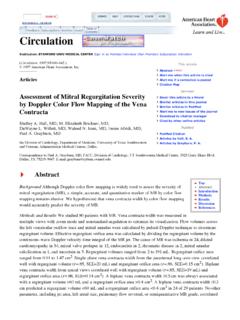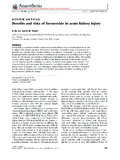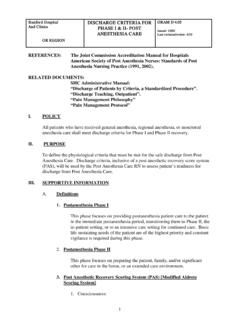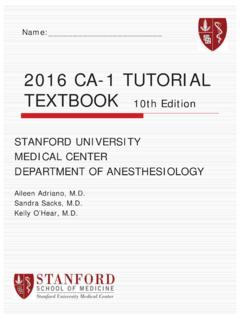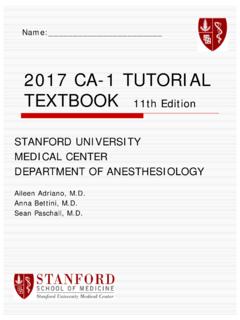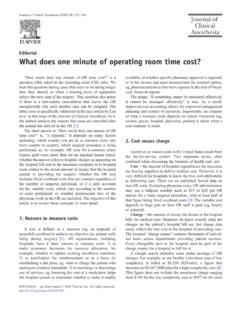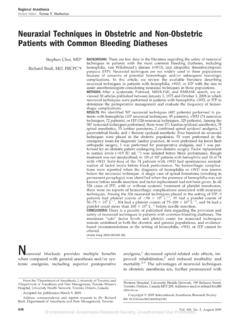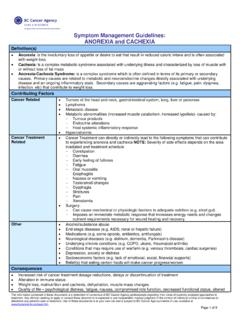Transcription of Colon surgeries vm 071512 - Stanford University
1 Different surgical procedures involving the Colon 1. Anatomy Right and left Colon are considered retroperitoneal whereas transverse and sigmoid Colon are intraperitoneal structures. First surgical step is mobilization of the Colon and its mesentery. Proximal and distal sites for anastomosis are selected and their mesentery divided. Primary anastomosis, diverting stoma (when unstable hemodynamics, infection etc) are then performed.
2 Stomas are surgically created openings between a hollow organ and the skin connected directly (or in some cases with the use of a tube). Stomas are used in situations in which diversion of, decompression of, or access to the bowel lumen is needed, for example in peritonitis, radiation enteritis or inflammatory bowel disease. Stomas can produce social and psychological problems, skin irritation, metabolic derangements (depending what part of the bowel is used and how high the output is), stoma retraction, prolaps, stenosis or ischemia.
3 2. Surgical things to look out for: For all procedures involving the Colon there are a couple of surgical things to look out for: ureters when mobilizing left splenic flexure or duodenum (therefore often times urology will be called in to place stents for better visualization of ureters to avoid that complication- especially in cases or prior abdominal surgeries or large tumor masses), bleeding from pelvic plexus, splenic injury, excessive traction on the liver leads to venous bleeding.
4 3. What are the procedures performed? Right hemicolectomy A right hemicolectomy is usually performed for cancer of the cecum and ascending Colon , and for some hepatic flexure. In a classic right hemicolectomy, the ileocolic, right colic, and right branch of the middle colic vessels are divided and removed with the contiguous mesentery. An ileocolic anastomosis is typically performed. Care must be taken to identify the right ureter, the ovarian or testicular vessels, and the duodenum.
5 If the omentum is attached to the tumor, it should be removed en bloc with the specimen. Extended right hemicolectomy An extended right hemicolectomy with an anastomosis between the ileum and the distal transverse Colon is according to Anderson Surgical Oncology Handbook, typically performed for cancer of the hepatic flexure and proximal transverse Colon . In the extended right hemicolectomy, the ileocolic, right colic, and middle colic vessels with their contiguous mesentery are divided and removed.
6 The inferior mesenteric vein may be divided and included in the specimen. Care must be taken to protect the duodenum, pancreas, and spleen. Cancer of the transverse Colon and splenic flexure can be resected with a modification of this procedure that includes resecting the Colon to the level of the proximal descending Colon . In this procedure, the ascending branch of the left colic artery is preserved, providing excellent blood supply to the distal anastomosis.
7 Transverse colectomy A transverse colectomy may be undertaken for mid transverse Colon cancers as long as satisfactory resection margins and an adequate lymphadenectomy can be obtained. The transverse Colon is resected along with the middle colic vessels and its mesentery. At times, the inferior mesenteric vein is also divided and included in the resected specimen. Both the hepatic and splenic flexures may need to be mobilized in order to achieve a tension- free anastomosis.
8 When mobilizing the splenic flexure, care must be taken not to apply much traction to the omentum or Colon , as this will invariably result in splenic capsule tears. Left hemicolectomy A left hemicolectomy is appropriate for tumors in the distal transverse or descending Colon and for selected patients with proximal sigmoid Colon cancer. The left branch of the middle colic vessels, the inferior mesenteric vein, and the left colic vessels along with their mesenteries are included with the specimen.
9 In some cases, a segmental colectomy may be performed as long as adequate resection margins and lymphadenectomy are achieved (Rouffet et al.) Sigmoid colectomy For sigmoid Colon cancers, segmental or sigmoid colectomy is appropriate. The inferior mesenteric artery is divided at its origin, and dissection proceeds just under the superior rectal vessels toward the pelvis until adequate margins are obtained.
10 As with right- sided tumors, care must be taken while mobilizing the sigmoid and descending Colon to identify the left ureter and the left ovarian or testicular vessels. Subtotal and total colectomy A subtotal or a total abdominal colectomy is indicated if there are synchronous neoplasms on the right and left sides of the Colon . Occasionally these procedures are performed in patients presenting with obstructing- left sided tumors.
